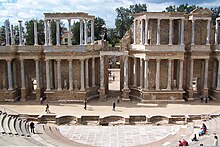Mérida is the capital of the Extremadura region in Spain. Founded in 25 BC, Mérida was once the capital of the Roman province of Lusitania. The city still contains numerous well preserved Roman ruins, the group of which were declared a UNESCO World Heritage site in 1993.
Get in
By train: The RENFE station in Mérida is located on Calle Cardero. There are four trains to and from Cáceres (trip time: 1 hr.), five trains to and from Madrid (4.5-6 hours, 18.45-27 Euros one-way), one to and from Seville (3 hr.), and seven to and from Badajoz (1 hr.)
By bus: The station is on Avenida de la Libertad near the train station. There are fewer buses to Madrid, but connections to Seville (6-8 busses per day) are much better.
Car: The N-V superhighway passes through Mérida from Madrid or Lisbon.
Get around
See
Roman ruins

Roman ruins in Mérida are a mixture of ticketed and free sites. At the ticket booth of any site that requires paid entry, you can purchase a combined ticket for all sites. The price is €12 and the ticket does not expire. You will also be given a map to the sites (both free and paid) around the city. Ticket sales are cash only.
- Roman Theater and Amphitheater. The star attraction of the Roman sites in Merida. The theater (used for plays) and amphitheater (used for gladiator fights and spectacles) are situated next to each other and both are excellently preserved. During the summer the theater is still used for flamenco and other shows. Ticket required.
- Casa del Mitreo. Uncovered remains of an old Roman mansion. Many original floor mosaics still visible. Ticket required.
- Roman Bridge (Puente Romano). Once the longest bridge in the Roman empire. Part original Roman construction, part restoration from the Visigoth era. Still used daily by pedestrians.
- Templo de Diana. Ruins of a large temple dedicated to the Roman empire, dating from the founding of the city. Parts of the structure were later reused in the Moorish period and after. Temple is in the city center. Free to view.
- Portico del Foro. Uncovered section of foundation of the old city Forum, with a few reconstructed columns. Free to view.
- Arch of Trajan. Large archway that was once one of principal entrances to the city. The surrounding structure has been lost but the arch itself remains standing in the midst of the modern city.
- The Alcazaba. Remains of a Moorish fortress built using material and part of the structure of the original Roman city walls. Can walk along the outer wall for a view of the river and old bridge. Ticket required.
- Circo Romano Hippodrome. The ruins of an ancient stadium where chariot races would have been held. Outside of the city center. Ticket required for entry.
- Rabo de Buey-San Lázaro Aqueduct. Across the street from the CIrco Romano, three pillars are all that remain of the structure of the Roman aqueduct. Better preserved remains from a 16th century aqueduct also stand in the same location. Open to the public
- Acueducto de los Milagros. Large, impressive section of a Roman aqueduct (three levels high) that runs across the center of what is now a city park. Free to visit.
- Zona Arqueológica de Morería. A small, mostly derelict, section of remains of the city entrance next the river that has been uncovered. Ticket required.
Do
Buy
Eat
Drink
Sleep
Go next
